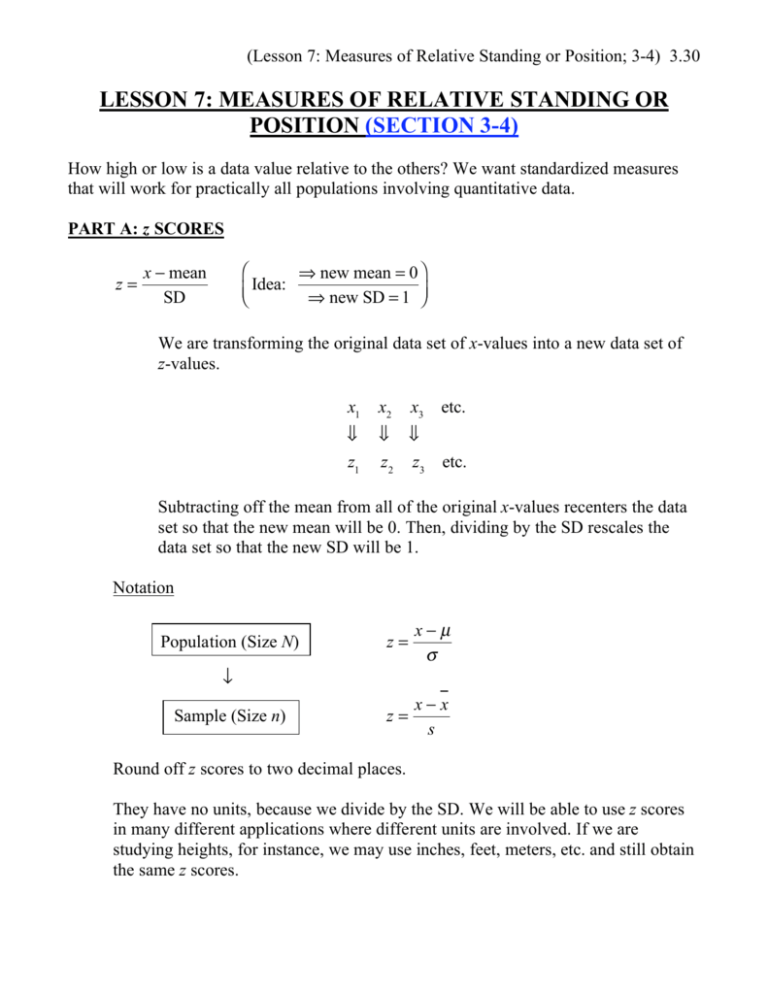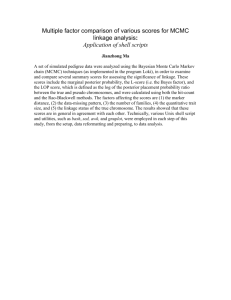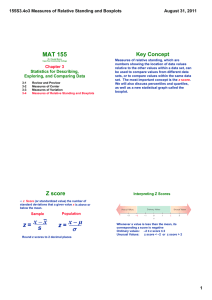LESSON 7: MEASURES OF RELATIVE STANDING OR POSITION
advertisement

(Lesson 7: Measures of Relative Standing or Position; 3-4) 3.30 LESSON 7: MEASURES OF RELATIVE STANDING OR POSITION (SECTION 3-4) How high or low is a data value relative to the others? We want standardized measures that will work for practically all populations involving quantitative data. PART A: z SCORES z= new mean = 0 Idea: new SD = 1 x mean SD We are transforming the original data set of x-values into a new data set of z-values. x1 x2 x3 etc. z1 z 2 z3 etc. Subtracting off the mean from all of the original x-values recenters the data set so that the new mean will be 0. Then, dividing by the SD rescales the data set so that the new SD will be 1. Notation Population (Size N) z= xμ z= xx s Sample (Size n) Round off z scores to two decimal places. They have no units, because we divide by the SD. We will be able to use z scores in many different applications where different units are involved. If we are studying heights, for instance, we may use inches, feet, meters, etc. and still obtain the same z scores. (Lesson 7: Measures of Relative Standing or Position; 3-4) 3.31 z Score Rule of Thumb for “Unusual” Data Values Data values whose corresponding z scores are either less than 2 or greater than 2 (i.e., z < 2 or z > 2 ) are often considered “unusual.” In other words, data values that are more than 2 SDs from the mean are often considered “unusual.” Think About It: How would you feel if your instructor tells you that your z score for the test you just took was 2.31 ? Example Two statistics classes take different tests. The mean and SD for Class 1 are: μ1 = 55 points , 1 = 5 points . The mean and SD for Class 2 are: μ2 = 60 points , 2 = 10 points . In which class is a score of 70 points more impressive? Solution Find the corresponding z scores for 70 points in the two classes. Class 1: Class 2: 70 55 5 = 3.00 z= 70 60 10 = 1.00 z= A score of 70 points is more impressive in Class 1; in fact, it is “unusually” high in that class. (Lesson 7: Measures of Relative Standing or Position; 3-4) 3.32 Note: If we assume normality in both classes, we have: PART B: FRACTILES, OR QUANTILES We will look at three types of these. Percentiles Example Because 92% of the scores lie below 85 points, we can say that the 92nd percentile of the data is 85: P92 = 85 points . (Lesson 7: Measures of Relative Standing or Position; 3-4) 3.33 Deciles Think: Dimes. 1st decile = D1 = P10 2 nd decile = D2 = P20 9 th decile = D9 = P90 Quartiles Think: Quarters. 1st quartile = Q1 = P25 2 nd quartile = Q2 = P50 3rd quartile = Q3 = P75 ( Median ) (Lesson 8: Boxplots; also 3-4) 3.34 LESSON 8: BOXPLOTS (ALSO SECTION 3-4) The Five-Number Summary can be represented graphically as a boxplot, or box-andwhisker plot. Boxplots can help us compare different populations, such as men and women. See the last page of the MINITAB handout.












